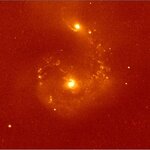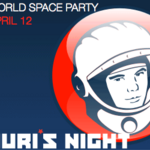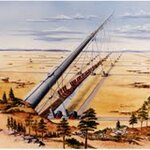Space

A new five-ton instrument that goes by the name MOSFIRE (Multi-Object Spectrometer for Infra-Red Exploration) has been installed in the Keck I Telescope at the W.M. Keck Observatory atop Mauna Kea in Hawaii.
MOSFIRE gathers light in infrared wavelengths — invisible to the human eye — allowing it to penetrate cosmic dust and see distant objects whose light has been stretched or "redshifted" to the infrared by the expansion of the universe. Basically, it will allow scientists to look 'back in time' and study the earliest galaxies in the universe
"The instrument was designed to…

12-4-12 Next Thursday is Yuri’s Night,
an international celebration of human achievement and ingenuity, in
recognition of mankind’s achievements in space exploration—with hopes of
inspiring a new generation to continue looking upward and reaching
outward. Fifty-one years ago, Yuri Gagarin was the first human to launch
into space. He later commented, “Circling the Earth in my orbital spaceship I marveled
at the beauty of our planet. People of the world, let us safeguard and
enhance this beauty – not destroy it!”
Do something on Yuri's
night. Look up some local or online event.…

Solar tornadoes several times as wide as the Earth can be generated in the solar atmosphere and one such solar tornado was discovered using the Atmospheric Imaging Assembly telescope on board the Solar Dynamic Observatory (SDO) satellite.
The Atmospheric Imaging Assembly saw superheated gases as hot as 50,000–2,000,000 Kelvin sucked from the root of a dense structure called the prominence, and spiral up into the high atmosphere and travel about 200,000 kilometers along helical paths for a period of at least three hours. The tornadoes were observed on September 25th, 2011. The hot gases in the…

SCUBA-2, the most powerful camera ever developed for observing light at ‘sub-mm’ wavelengths (light that has a wavelength 1000 times longer than we can see with our eyes), has begun a revolutionary new study of cosmic star-formation history.
SCUBA-2 is mounted on the world's largest sub-mm telescope, the 15-meter James Clerk Maxwell Telescope in Hawaii. The new project, called the SCUBA-2 Cosmology Legacy Survey, will run for three years and will use the camera to provide the clearest view to date of dust-enshrouded star-forming galaxies. These objects are so remote that the light we…

The Hubble Legacy Archive is now open for you to browse ! Thousands of unscrutinized images of the sky as pictured by the Hubble Space Telescope are there for you to browse, reprocess, analyze. They even challenge you to find hidden treasures, and submit them for their scrutiny. It is a marvelous opportunity to get personal with all the beauties of our cosmos. There is an online tool for changing colours and contrast of each picture.
Have a look at what you can find with just seconds of searches: the picture below portraits one of my favourite targets in late summer nights, Stephan's quintet…

The region around the Hubble Deep Field (HDF), originally captured by the Hubble Space Telescope (HST) in the mid 1990s, led to the discovery of numerous galaxies billions of light years distant and provided direct visual evidence of the evolution of the Universe. First results from the new imaging, which uses observations from the UK's newly upgraded e-MERLIN radio telescope array together with the EVLA radio array based in New Mexico, show galaxies some 7 billion light years away in unprecedented detail.
e-MERLIN is an array of radio telescopes distributed across the United Kingdom…

Although for at least 10 years, since the WMAP satellite first measured the amounts of dark matter in the universe, scientists have known the recipe for the universe (4.5% Matter,22.5% Dark Matter, 73% Dark Energy) but really didn't have a clue as to what the Dark Matter and Energy of the universe actually is. One theory of dark matter is a WIMP, a weakly interacting massive particle left over from the big bang, is the lightest super-symmetric particle, LSP. That theory fit in well with the prevailing super-string and super-symmetry theories of particle physics, and the numbers actually…

The notion of gun-propelled launch goes back to Jules Verne. Such Mass Drivers have been envisioned in numerous Sci Fi tales, including "Earthlight", by Arthur C. Clarke, Robert A. Heinlein's "The Moon is a Harsh Mistress" and "Heart of the Comet" by Benford&Brin. We've also seen them portrayed in Buck Rogers, Babylon 5 and Halo.
Now, two researchers propose that a space-capable mass driver may be feasible. Startram would act as an electromagnetic catapult, using maglev technology, to accelerate and launch spacecraft into orbit, without using rockets or propellant. James Powell and…

Quasars, powered by supermassive black holes, are among the brightest objects in the universe, outshining the total starlight of their host galaxies.
Quasar host galaxies are hard or even impossible to see because the central quasar far outshines the galaxy. Therefore, it is difficult to estimate the mass of a host galaxy based on the collective brightness of its stars. However, gravitational lensing candidates are invaluable for estimating the mass of a quasar's host galaxy because the amount of distortion in the lens can be used to estimate a galaxy's mass.
Astronomers using NASA…

A research team has announced discovery of molecular oxygen ions (O2+) in the upper atmosphere of Dione, one of the 62 known moons orbiting Saturn.
Dione was discovered in 1684 by astronomer Giovanni Cassini and NASA's Cassini spacecraft, which was launched in 1997, detected the oxygen ions. Dione orbits Saturn at roughly the same distance as our own moon orbits Earth but the tiny moon is a mere 700 miles wide and appears to be a thick, pockmarked layer of water ice surrounding a smaller rock core. As it orbits Saturn every 2.7 days, Dione is bombarded by charged particles (ions)…